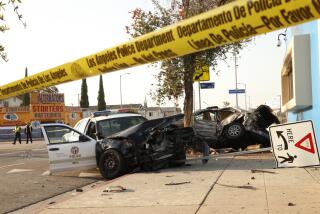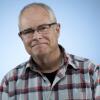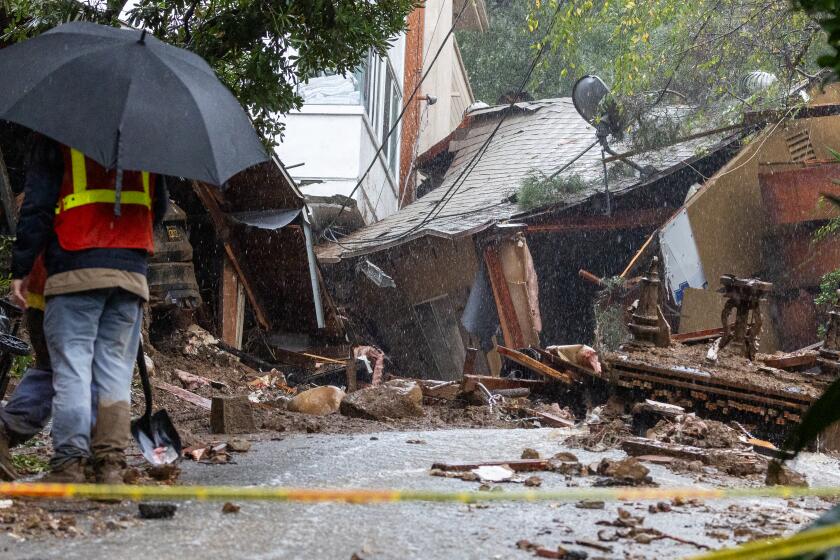The parking lot is a mess, cars prowling for an empty space, shoppers weaving through the tangle with overloaded carts. “Nightmare” is the word Amber Mooers uses to describe the Sunday turmoil at her local Costco in Alhambra.
“There are people literally tailgating each other,” Mooers says as she loads groceries into the back of a car. “Everyone is vulturing for a spot near the front.”
If you live in or around Los Angeles, you probably have a parking lot like this in your life. Too many cars, not enough spaces, too much chaos. Maybe a Trader Joe’s or an In-N-Out Burger that makes your pulse quicken as you pull into the driveway.
“It’s pretty common,” Gordon Meth says. “What happens is, they are often laid out by architects or site engineers who don’t really know about traffic control.”
Meth is a certified parking geek, a civil engineer with decades of experience in design consulting and expert testimony in civil trials. Most of us judge a lot by its spaces — Too skinny! Too short! — but he dives deeper.
Flow, friction, sight triangles.

As an associate at Pennsylvania-based Robson Forensic, Meth bemoans the lack of research on this arcane subject and muses about someday publishing his own guidelines. The Times recently met him at a Starbucks in Burbank where parking was hard to find.
With satellite photos strewn across the table and drone video playing over a laptop, we evaluated a sampling of L.A.’s worst parking lots: What makes them so bad? And could they be improved?
Trader Joe’s in Pasadena
Trader Joe’s in Pasadena
It’s no secret this supermarket chain prefers small stores — square footage-wise — requiring fewer parking spaces per zoning rules. But something else is at work here.
Though drivers often focus on space size, the interaction between pedestrians and drivers has a greater impact on parking, Meth says. At the original Trader Joe’s on Arroyo Parkway, the handicapped spaces are located too far from the entrance, there is an awkward diagonal crosswalk and shoppers amble in all directions, often moving down the middle of the aisle for fear of someone backing out suddenly. This dynamic is called “shy distancing” and can hamper traffic flow.
The solution? Research shows 30% to 40% of people comply with high-visibility markings, which makes a difference, Meth says. The store could move those handicapped spots closer to the entrance, funnel foot traffic into a better-designed crosswalk and even add another walkway around the perimeter.
“To fix a parking lot, it doesn’t take a lot,” Meth says. “It’s striping and signs and maybe you lose a couple slots.”
Food 4 Less in Westlake
Food 4 Less in Westlake
The problem here is “frontage.”
Cars, foot traffic and raiteros — pirate taxis waiting for customers — converge around the main entrance to this supermarket in one of L.A.’s most densely populated neighborhoods.
“People shop here because they can afford it,” says Set Soto, who has come for beer. “That brings the multitudes.”
Congestion in front of a supermarket can reverberate throughout a lot, even a big one such as this. Meth says it is worth removing a dozen or so parking spaces to add stop signs and islands — those small, curbed planters — at the end of each aisle. Better visibility equals smoother flow.
The islands, in particular, “open up sight triangles so that people aren’t coming in blind,” he says. “That keeps friction off the [frontage].”
The Cheesecake Factory has an official taste tester for every dish on that hefty menu. He’s also CEO of the eatery people love or loathe so much it’s meme-worthy.
In-N-Out Burger in West Carson
In-N-Out Burger in West Carson
Lunchtime brings the usual rush, a line of cars stretching out the driveway and into the street. This isn’t uncommon for In-N-Outs that combine drive-through with conventional dining.
“The confluence of the two is an issue,” Meth says. “They are totally different animals.”
The challenge is having enough “stacking” capacity — space to keep the drive-through line away from everything else. At this location, waiting cars hamper entrance to an adjoining lot of 18 spaces.
Though costly, a remodel that shifts the drive-up windows to the far corner of the building — farthest from the driveway — would increase the stacking space, Meth says. He also suggests adding a divider between drive-through and parking.
“You want something to make them separate,” he says. “If you don’t have that space, you’re going to have overflow.”
Riviera Village in Redondo Beach
Riviera Village in Redondo Beach
This oddly shaped lot harks back to a time when more people drove compact cars. Slots designed for 15-foot-long Honda Civics must now accommodate a Ford F-150 pickup with crew cab that stretches past 20 feet.
Asked about shoppers in oversized vehicles, Meth hesitates to offer a solution.
“Why should we make it easier for them?” he asks. “I personally don’t like rewarding bad behavior.”
Another problem: Public streets border the triangular lot on all three sides and drivers must exit into traffic, then reenter at the next driveway. Meth says: “You’re forcing people onto the road just to circulate, and that’s bad.”
Since city planners probably won’t close the adjacent streets, the only option is to rip out enough spaces for circulation inside the property line.
Whole Foods in Woodland Hills
Whole Foods in Woodland Hills
“Self-preservation” is the word Meth uses.
Cars enter the lot behind the Whole Foods from two directions, converging at a blind corner where the view is blocked by the supermarket. Constant foot traffic makes things even more treacherous.
Drivers often start and stop, inching their way up, straining to see what’s around the corner.
“It’s not open and obvious, right?” Meth says. “People have to go slow in fear of somebody coming up.”
A simple, cheap modification — stop signs for each direction — would make things smoother. Drivers could pull right up, pause, and take their turns without worry.
Why are so many California EV charging stations broken? Lax state oversight of state subsidies is one big reason.
Costco in Alhambra
Costco in Alhambra
Analyzing this vast lot, Meth sees empty spots at the far edges. The challenge is getting shoppers from the store’s entrance, through all that traffic, to these underutilized areas.
“Probably they don’t feel safe pushing their shopping carts across the lot,” Meth says.
Several crosswalks lead from the front door to the first rows of parking, but customers must fend for themselves after that. Walkways should extend farther.
“Basically, you’re showing them the path,” Meth says. “Take out a few parking spots and take them back to that area.”
Every other parking lot in L.A.
None of this is rocket science.
Crosswalks and stop signs, circulation roads and well-placed islands — simple design and a little appreciation for human behavior can solve most parking problems. Given that zoning laws tend to address number of spaces but little else, the onus is on stores and property owners.
The Times reached out to several companies mentioned in this story but received no response.
Meth would like to see industry standards revised to make parking safer and easier. Still, he concedes, some lots can’t be fixed.
“The ones that are crowded and have almost no parking,” he says. “In that case, there’s not much you can do.”
Transportation is the largest sector of planet-warming gases, yet Americans won’t let go of their cars. Autos can mean freedom, but so can leaving them behind.
More to Read
Subscriber Exclusive Alert
If you're an L.A. Times subscriber, you can sign up to get alerts about early or entirely exclusive content.
You may occasionally receive promotional content from the Los Angeles Times.





















